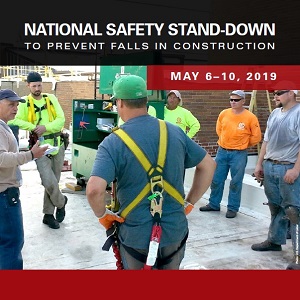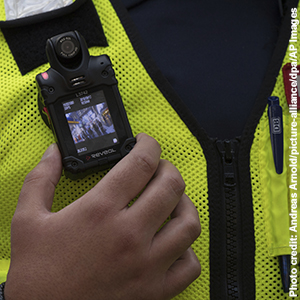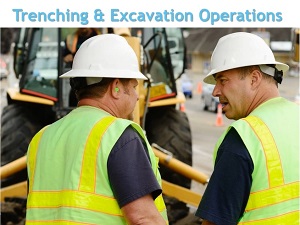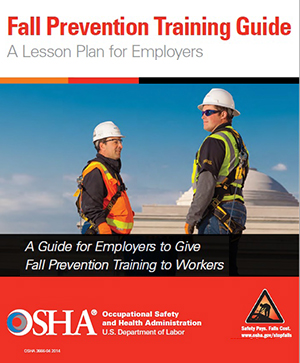Friday, February 22, 2019
New Video Provides Information on Trenching and Excavation Safety
A new video developed by Dallas-area OSHA Training Institute Education Centers offers guidance on how to prevent injuries from common hazards in trenching and excavation. The one-hour video focuses on cave-in protection, competent persons, and best practices. Register online to receive a link to this free video.
Sixth Annual National Stand-Down to Prevent Falls: May 6-10, 2019
 OSHA and its partners will host events throughout the country in honor of the sixth annual National Safety Stand-Down to Prevent Falls in Construction May 6-10, 2019. Employers and workers will pause to talk about fall hazards, OSHA compliance, and industry best practices to prevent falls. The 2019 poster is now available on OSHA’s publications page.
OSHA and its partners will host events throughout the country in honor of the sixth annual National Safety Stand-Down to Prevent Falls in Construction May 6-10, 2019. Employers and workers will pause to talk about fall hazards, OSHA compliance, and industry best practices to prevent falls. The 2019 poster is now available on OSHA’s publications page.
OSHA Urges Employers to Prevent Worker Exposure to Carbon Monoxide
OSHA is reminding employers to take necessary precautions to protect workers from the potentially fatal effects of carbon monoxide exposure. Every year, workers die from carbon monoxide poisoning, usually while using fuel-burning equipment, tools, compressors and pumps, gas-powered forklifts, and other devices in buildings or semi-enclosed spaces without adequate ventilation. To reduce the risk of exposure, employers should install an effective ventilation system, use carbon monoxide detectors, and take other precautions as described in OSHA's Carbon Monoxide Fact Sheet. Other OSHA resources include videos (in English and Spanish), QuickCards (in English and Spanish), and a fact sheet on portable generator safety.
Working Safely with Portable Generators
 Portable generators are internal combustion engines used to generate electricity when temporary or remote power is needed. OSHA's portable generator fact sheet focuses on how to protect workers from hazards associated with the use of this equipment. These hazards include exposure to carbon monoxide from a generator's exhaust, shocks and electrocution, and fires from ignited generator fuel.
Portable generators are internal combustion engines used to generate electricity when temporary or remote power is needed. OSHA's portable generator fact sheet focuses on how to protect workers from hazards associated with the use of this equipment. These hazards include exposure to carbon monoxide from a generator's exhaust, shocks and electrocution, and fires from ignited generator fuel.
Bulletin Addresses Safety for Workers Wearing Devices Containing Lithium Batteries
 A new OSHA bulletin addresses hazards associated with small, wearable devices powered by lithium batteries, such as body cameras. If these devices are damaged or defective, they may catch fire or explode. Employers should ensure that workers are trained to properly use, store, and charge these devices; identify, remove, and properly dispose of damaged or defective devices and batteries; and provide information on their health and physical hazards.
A new OSHA bulletin addresses hazards associated with small, wearable devices powered by lithium batteries, such as body cameras. If these devices are damaged or defective, they may catch fire or explode. Employers should ensure that workers are trained to properly use, store, and charge these devices; identify, remove, and properly dispose of damaged or defective devices and batteries; and provide information on their health and physical hazards.
New FAQs Available on Controlling Silica in General Industry
 OSHA posted new frequently asked questions (FAQs) on the standard for respirable crystalline silica in general industry. OSHA developed the FAQs in consultation with industry and union stakeholders to provide guidance to employers and workers on the standard's requirements, including exposure assessments, regulated areas, methods of compliance, and communicating silica hazards to workers. Visit OSHA's silica standard for general industry webpage for more information and additional compliance assistance resources.
OSHA posted new frequently asked questions (FAQs) on the standard for respirable crystalline silica in general industry. OSHA developed the FAQs in consultation with industry and union stakeholders to provide guidance to employers and workers on the standard's requirements, including exposure assessments, regulated areas, methods of compliance, and communicating silica hazards to workers. Visit OSHA's silica standard for general industry webpage for more information and additional compliance assistance resources.
OSHA Provides Compliance Assistance Resources to Protect Workers from Falls
Falls remain the leading cause of worker fatalities in the construction industry. Working with industry stakeholders, OSHA developed a collection of compliance assistance resources to raise awareness of common fall hazards in construction, educate employers and workers on fall prevention, and reduce the number of fall-related injuries and fatalities. These resources include the National Safety Stand-Down to Prevent Falls in Construction to be held May 6-10; a series of fall safety videos; a Fall Prevention Training Guide; fact sheets on ladders and scaffolding; and a brief video, 5 Ways to Prevent Workplace Falls. For more information, read the news release and visit OSHA's Fall Prevention webpage.
Subscribe to:
Posts (Atom)


